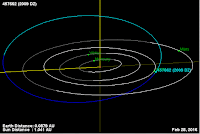Asteroid 2007 DM41 passed by the Earth at a distance of 12 400 000 km
(32.3 times the average distance between the Earth and the Moon, or
8.29% of the average distance between the Earth and the Sun), slightly
before 12.10 pm GMT on Tuesday 23 February 2016. There was no danger of
the asteroid hitting us, though had it done so it would have presented a
considerable threat. 2007 DM1 has an estimated equivalent
diameter of 78-250 m (i.e. a spherical body with the same mass would be
78-250 m in diameter), and an object towards the upper end of this range
would pass through the atmosphere and directly impact the ground with a
force of about 600 megatons (about 35 000 times the
explosive energy of
the Hiroshima bomb), causing devastation over a wide area and creating a
crater about 4 km across, and resulting in global climatic problems that
could last for decades.
2007 DM1 was discovered on 23 February 2007 by the University of Arizona's Catalina Sky Survey, which is located in the Catalina Mountains north of Tucson. The designation 2007 DM1 implies that it was the 38th asteroid (asteroid M1) discovered in the second half of February 2007 (period 2007 D).
2007 DM1 has a 469 day orbital period and an eccentric orbit tilted at an angle of 2.26° to the plane of the Solar System, which takes it from 0.56 AU from the Sun (i.e. 56% of the average distance at which the Earth orbits the Sun, and between the orbits of the planets Mercury and Venus) to 1.80 AU from the Sun (i.e. 180% of the average distance at which the Earth orbits the Sun, and considerably outside the orbit of the planet Mars). It is therefore classed as an Apollo Group Asteroid (an asteroid that is on average further from the Sun than the Earth, but which does get closer). This means that close encounters between the asteroid and Earth are extremely common, with the last having occurred in June 2012 this year and the next predicted in October 2017 . As an asteroid probably larger than 150 m in diameter that occasionally comes within 0.05 AU of the Earth, 2007 DM1 is also classified as a Potentially Hazardous Asteroid.
2007 DM1 also
has frequent close encounters with the planets Mercury (which it last
came close to in March 2002 and is predicted to pass again in June 2048),
Venus (which it last came close to in February 2011 and is predicted to
pass again in December 2027) and Mars (which it last came close to in March 1959 and is predicted to pass again in August 2032). Asteroids
which make close passes to multiple planets are considered to be in
unstable orbits, and are often eventually knocked out of these orbits by
these encounters, either being knocked onto a new, more stable orbit,
dropped into the Sun, knocked out of the Solar System or occasionally
colliding with a planet.
See also...
 Asteroid (457662) 2009 DZ passes the Earth. Asteroid
(457662) 2009 DZ passed by the Earth at a distance of 12 510 000 km
(32.5 times the average distance between the Earth and the Moon, or
8.36% of the average distance between the Earth and the Sun), slightly
before 2.35 am GMT on Tuesday 23...
Asteroid (457662) 2009 DZ passes the Earth. Asteroid
(457662) 2009 DZ passed by the Earth at a distance of 12 510 000 km
(32.5 times the average distance between the Earth and the Moon, or
8.36% of the average distance between the Earth and the Sun), slightly
before 2.35 am GMT on Tuesday 23... Asteroid 2016 DB passes the Earth. Asteroid
2016 DB passed by the Earth at a distance of 123 900 km (0.32 times
the average distance between the Earth and the Moon, or 0.08% of
the average distance between the Earth and the Sun; 103 900 km above the
orbit at which the satellites supporting...
Asteroid 2016 DB passes the Earth. Asteroid
2016 DB passed by the Earth at a distance of 123 900 km (0.32 times
the average distance between the Earth and the Moon, or 0.08% of
the average distance between the Earth and the Sun; 103 900 km above the
orbit at which the satellites supporting... Fireball seen over southern France and northern Italy. A bright fireball was seen over much of southeast France and northern
Italy at about 6.20 pm local time on Wednesday 17...
Fireball seen over southern France and northern Italy. A bright fireball was seen over much of southeast France and northern
Italy at about 6.20 pm local time on Wednesday 17...
Follow Sciency Thoughts on Facebook.

